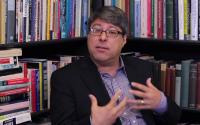8 January 2007The Independent
One of the greatest mysteries of the universe is about to be unravelled with the first detailed, three-dimensional map of dark matter - the invisible material that makes up most of the cosmos.
Astronomers announced yesterday that they have achieved the apparently impossible task of creating a picture of something that has defied every attempt to detect it since its existence was first postulated in 1933.
Scientists have known for many years that there is more to the universe than can be seen or detected through their telescopes but it is only now that they have been able to capture the first significant 3D-image of this otherwise invisible material.
Unlike the ordinary matter of the planets, stars and galaxies, which can be seen through telescopes or detected by scientific instruments, nobody has seen dark matter or knows what it is made of, though calculations suggest that it is at least six times bigger than the rest of the visible universe combined.
A team of 70 astronomers from Europe, America and Japan used the Hubble space telescope to build up a picture of dark matter in a vast region of space where some of the galaxies date back to half the age of the universe - nearly 7 billion years.
They used a phenomenon known as gravitational lensing, first predicted by Albert Einstein, to investigate an area of the sky nine times the size of a full moon. Gravitational lensing occurs when light from distant galaxies is bent by the gravitational influence of any matter that it passes on its journey through space.
The scientists were able to exploit the technique by collecting the distorted light from half a million faraway galaxies to reconstruct some of the missing mass of the universe which is otherwise invisible to conventional telescopes.
"We have, for the first time, mapped the large-scale distribution of dark matter in the universe," said Richard Massey of the California Institute of Technology in Pasadena, one of the lead scientists in the team. "Dark matter is a mysterious and invisible form of matter, about which we know very little, yet it dominates the mass of the universe."
One of the most important discoveries to emerge from the study is that dark matter appears to form an invisible scaffold or skeleton around which the visible universe has formed.
Although cosmologists have theorised that this would be the case, the findings are dramatic proof that their calculations are correct and that, without dark matter, the known universe that we can see would not be able to exist.
"A filamentary web of dark matter is threaded through the entire universe, and acts as scaffolding within which the ordinary matter - including stars, galaxies and planets - can later be built," Dr Massey said. "The most surprising aspect of our map is how unsurprising it is. Overall, we seem to understand really well what happens during the formation of structure and the evolution of the universe," he said.
The three-dimensional map of dark matter was built up by taking slices through different regions of space much like a medical CT scanner build a 3-D image of the body by taking different X-ray "slices" in two dimensions.
Data from the Hubble telescope was supplemented by measurements from telescopes on the ground, such as the Very Large Telescope of the European Southern Observatory in Chile and the Japanese Subaru telescope in Hawaii.
Details of the dark matter map were released yesterday at the annual meeting of the American Astronomical Society in Seattle and published online by the journal Nature. The map stretches half way back to the beginning of the universe and shows that dark matter has formed into "clumps" as it collapsed under gravity. Other matter then grouped around these clumps to form the visible stars, galaxies and planets.
"The 3-D information is vital to studying the evolution of the structures over cosmic time," said Jason Rhodes of the Jet Propulsion Laboratory in Pasadena.
Astronomers have compared the task of detecting dark matter to the difficulty of photographing a city at night from the air when only street lights are visible.
Scientists said the new images were equivalent to seeing a city, its suburbs and country roads in daylight for the first time. Major arteries and intersections become evident and a variety of neighbourhoods are revealed.
"Now that we have begun to map out where dark matter is, the next challenge is to determine what it is, and specifically its relationship to normal matter," Dr Massey said. "We have answered the first question about where the dark matter it, but the ultimate goal will be to determine what it is."
Various experiments on Earth are under way to try to find out what dark matter is made of. One theory is that it is composed of mysterious sub-atomic particles that are difficult to detect because they do not interact with ordinary matter and so cannot be picked up and identified by conventional scientific instruments. Comparing the maps of visible matter and dark matter have already pointed to anomalies that could prove critical to the understanding of what constitutes dark matter.






